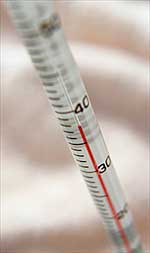Measuring body temperature: What method to use?
Rectal temperature measurements are considered the “gold standard” for measuring core body temperature.
Body temperature is routinely measured as 1 of the 4 “vital signs” and, when elevated, triggers a search for an explanation. Nonetheless, scientific data that define normal temperatures in healthy individuals using the various devices that are currently available are sadly lacking.
Rectal temperature measurements are considered the “gold standard” for measuring core body temperature. Does placing a thermometer into the rectal vault, containing various amounts of stool and surrounded by large muscles which require a relatively long time to heat up or cool down accurately reflect the temperature of arterial blood? I seriously doubt it. There is, however, a long history of using rectal temperature measurements in infants and young children and oral temperatures in older children and adults to ascertain whether an individual is febrile.
Temperature measurements in healthy individuals with no reason to have fever have been published for a small number of individuals. Bayley and Stolz measured rectal temperatures on 60 healthy children, Iliff and Lee measured rectal temperatures on 129 infants and children and 172 children and adolescents, and Herzog and Coyne used retrospective data from 691 infants to determine normal rectal temperatures. Some of the ambiguity regarding normal temperature is reflected in the wide range of responses when physicians are asked to define what they consider fever.
Introducing new devices

When a new device for measuring temperature is introduced the question that is usually asked is how do temperatures measured with this new device compare to rectal or oral measurements? When ear temperatures (using First Temp 2000A, Intelligent Medical Systems Inc.) were compared with rectal temperatures, investigators found a statistical correlation between the two but also found that mean ear temperatures were significantly lower than rectal temperatures. Thus, measuring ear temperature and using definitions for fever based on rectal temperatures would result in misdiagnosing many children with fever. Using a different ear thermometer (LighTough Pedi-Q, Exergen Corp.) we found the average ear and rectal measurements to be almost identical. However, at the low end of the temperature scale, ear temperatures tended to be higher, and at the high-end ear temperatures were lower. A study in healthy children showed that ear temperatures above 37.8° C represent fever compared with 38.0° C for rectal measurements.
Nurses in our hospital measure axillary temperature when they do not want to upset a child, despite that literature comparing rectal measurements with axillary measurements (with the possible exception of newborns) has repeatedly demonstrated that axillary measurements cannot be trusted to detect fever.
Studies using liquid crystal forehead strips have repeatedly shown that fevers can easily be missed, especially in infants younger than 2 years. An electronic pacifier thermometer compared with rectal measurements had a sensitivity of only 72% in detecting fever (to many false negatives) and if 0.5° F were added to the pacifier measurement the sensitivity fell to 76% (to many false positives). The ability of caregivers to tell whether a child has fever by various means of palpation is generally about 50%. Caregivers are correct about 90% of the time when they say that their children do not feel feverish.
Are all temperatures created equal?
Is the expectation that a rectal temperature and a forehead, ear, oral, axillary or temporal artery temperature should be the same realistic? I think not. Manufacturers of new devices should be required to provide information regarding the distribution of temperatures in a large number of healthy individuals representing various ages. These data would define fever (temperatures greater than 2 standard deviations above normal for age) using their device. A temporal artery thermometer is available as are data comparing it to rectal measurements. We are in the process of measuring temporal artery temperatures on 2,000 healthy infants, children, and adolescents with no reason to be febrile. We do not plan on using this instrument in our practices until these data have been analyzed and we know how to interpret the temperature we read.
For more information:
- Bayley N and Stolz HR. Maturational changes in rectal temperatures of 61 infants from 1 to 36 months. Child Development. 1937;8:195-206.
- Iliff A and Lee VA. Pulse rate, respiratory rate, and body temperature of children between two months and eighteen years of age. Child Development. 1952;23:237-245.
- Herzog LW and Coyne LJ. What is fever? Normal temperature in infants less than 3 months old. Clin Pediatr. 1993;32:142-146.
- Brennan DF, Falk JL, Rothrock SG, et al. Reliability of infrared tympanic thermometry in the detection of rectal fever in children. Ann Emerg Med. 1995;25:21-30.
- Loveys AA, Dutko-Fioravanti I, Eberly SW, et al. Comparison of ear to rectal temperature measurements in infants and toddlers. Clin Pediatr. 1999;38:463-466.
- Powell KR, Smith K, Eberly SW. Ear temperature measurements in healthy children using the arterial heat balance method. Clin Pediatr. 2001 (in press).
- Kresch MJ. Axillary temperature as a screening test for fever in children. J Pediatr. 1984;104:596-599.
- Brown PJ, Christmas BF, Ford RPK. Taking an infant’s temperature: axillary or rectal thermometer? NZ Med J. 1992;105:309-311.
- Press S, Quinn BJ. The pacifier thermometer. Comparison of supralingual with rectal temperatures in infants and young children. Arch Pediatr Adolesc Med. 1997;151:551-554.
